It’s here and it’s a sensory overload. If the severe CityCenter six-pack is a convent of Carmelite nuns, The Cosmopolitan of Las Vegas is a drag queen. It’s unstintingly flamboyant, often fabulous, unremittingly outrageous and campy as all get-out. On the inside, anyway. The exterior remains one of the great architectural underachievements of post-Mirage Vegas. Barring a convex wall hither and a modest diagonal slope thither, it’s a design that looks as though nerve ran out well before the money did …
 The Cosmopolitan you’ll never see.
The Cosmopolitan you’ll never see.
Inside, Cosmo’s a far different story and nobody will look at it and ask, “Where did the $3.9 billion go?” In sensibility, it’s the gayest thing to hit the Strip since Liberace. Few styles — and nary a decorative material — have been spared in this blitzkrieg upon your eyeballs. It’s aesthetic Babel: a deafening proliferation of visual languages yelling at one another simultaneously, with no single dialect achieving dominance.
More for that reason than despite it, patrons will warm to the Cosmo as they never did to its austere rival, Aria. The former proclaims “Fun!” where the latter means to Improve You. Cosmo meets you at the street, whereas Aria demands that customers alter their grazing pattern to make the long climb up to the casino, a block away.
The flamboyance begins once inside the porte-cochere, an unobtrusive tunnel off Harmon Avenue. Giant silver letters proclaim THE COSMOPOLITAN, and the driveway is lined with chandeliers and pillars that are bedizened with hundreds of tiny bulbs. Entrances are guarded by statues of Chinese dragons, in a random gesture toward the Asian market. (Aria retrofitted its entrances with some of these gremlins, too, as an incongruous afterthought.)
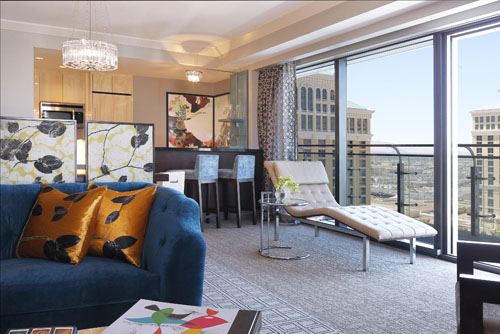
Even the kitchen sink. Inside, Cosmo fairly shouts “GAUDY!” and “GLITZY!” People don’t come to Las Vegas for tasteful restraint and Cosmo makes Encore look self-effacing. If it or Bellagio evoke a relaxed feeling, the barrage of visual cues at Cosmo will give you the heebie-jeebies — and one suspects that was the idea. It’s as though an army of rival decorators (14 discrete firms are credited) was set loose with no directive other than to outdo each other and let money be no object. The kind of selective lavishness practiced by Steve Wynn and Roger Thomas is here thrown completely to the winds, from the onyx flooring to the mirrored ceilings. However, for its proliferation of materials and surfaces, Cosmo rarely has the tactile appeal of Encore. You won’t cop as many feels of the decor.
Speaking in tongues. The “West” (actually north) check-in lobby alone is visually trilingual. To the right is a wide, utilitarian corridor, its walls covered in stamped leather. (Even the most functional public areas of Wynncore and Venelazzo are plusher.) In the middle stand two rows of columns. Eight of them display wraparound CGI artwork by Digital Kitchen. By day, butterflies cavort over silhouetted flowers or virtual library shelves surround one. “More sexy” imagery is promised for after dark.
To the left is a row of red, studded-felt check-in desks, designed in Louis XIV style and intended to facilitate more personal guest/clerk interaction. Elevators to the West Tower open immediately onto the lobby but woe betide the guest booked into the East Tower. You either have to take an elevator to the second floor and traverse it or lug your luggage across the casino floor … which promises to be awkward with a capital “A.”
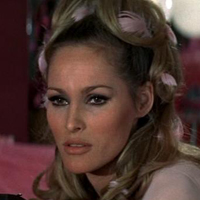 Upskirt. Subtly linking the casino floor and lobby is the Vesper Bar (yes, a Casino Royale reference), its furniture a weird mix of styles from Modernist egg-cup barstools to elaborately embroidered settees. Overhead, the ceiling alternates endless pleats — inspired by the petticoats in Alice in Wonderland, we were told — with raindrop-like glass globes. An ornate, Old World bar cabinet is incongruously shoehorned into the space, so tall it intrudes into the ceiling decor. With its $5-$6 beers and $10-$14 cocktails, the Vesper Bar almost qualifies as a Strip bargain and offers a limited breakfast menu, too. Victorian couches nearby are accessorized with old-style white telephones of the type synonymous with the cinema of Mussolini-era Italy.
Upskirt. Subtly linking the casino floor and lobby is the Vesper Bar (yes, a Casino Royale reference), its furniture a weird mix of styles from Modernist egg-cup barstools to elaborately embroidered settees. Overhead, the ceiling alternates endless pleats — inspired by the petticoats in Alice in Wonderland, we were told — with raindrop-like glass globes. An ornate, Old World bar cabinet is incongruously shoehorned into the space, so tall it intrudes into the ceiling decor. With its $5-$6 beers and $10-$14 cocktails, the Vesper Bar almost qualifies as a Strip bargain and offers a limited breakfast menu, too. Victorian couches nearby are accessorized with old-style white telephones of the type synonymous with the cinema of Mussolini-era Italy.
The Big C. The casino floor, designed by Friedmutter Group, is as much a success as Aria’s was a colossal dud. (By the numbers: 1,478 slots, 41 bar-top machines and 83 tables.) A few “gaming cabañas” — beaded curtains and bottle service for high rollers — are a nod to the semi-private salons of Encore but that’s as close to a chambered look as Cosmo gets, although bejeweled soffits effectively diminish the ceiling’s height. The long curve of the casino floor looks considerably cozier than its 100,000 square feet would suggest, as Friedmutter has cunningly wrapped it around the central tower of bars — known as “The Chandelier” — in an elongated “C.” Light fixtures resemble clouds of feathers or garlands of red leaves. The Book & Stage lounge protrudes into the gaming floor in a bright, lucite “V.” We’re worlds away from the dank vibe of Aria. Even though the latter’s casino lighting quotient has been upped, the prevalence of very dark colors in its design negates the added wattage.
Playpen. Cosmo’s slot floor is considerably more conducive to a feeling of play. Although as server-based as Aria’s, deploying International Game Technology‘s platform, the slot cabinetry is higher-profile and more attention-getting, replete with brilliant LCD screens. No rows of dumb terminals here. Participation games — including a big-ass Wheel of Fortune carousel — are considerably more in evidence, too. The Chandelier‘s tri-level form is swathed in 2 million crystals. When you’re inside the bar(s), they create a womb-like affect and soothing imagery, such as red roses, is projected upon them. The furniture is so slick, however, that your butt may slide clear off it. The topmost level is the most spacious but also the most public, too.
Back on terra firma, Queue Bar‘s the concrete-honeycomb pattern of its walls is picked up subtly in the woodwork of the bar itself. A blackjack pit is overseen by a giant laminated eyeball in the ceiling, metaphorical of the omniscient “eye in the sky.” To the Strip side of the casino, Bond‘s design, with its low-slung furniture, eschews sharp angles and lights ripple through streams of LED beads. The plush, dark-brown stylings of The Henry are deliberately more subdued, even if its logo is a clear shout-out to the Ed Hardy-wearing crowd (read: douchebags).
Dining with Señor Mao. The mall level boasts retailers all new to Las Vegas, including a high-end food store for those who take their in-room kitchenettes (a legacy of the hotel-condo delirium) seriously. There’s Allsaints Spitalfields (British designer clothes), Stitched (tailored suits “for the man who likes a handmade lifestyle”), Jason of Beverly Hills, jeweler to the L.A. Lakers — and you can’t get any classier than that, can you? — Molly Brown’s (swimwear), Beckley (chick stuff), DNA 2050 (denim from around the globe), Skins 6/2 (cosmetics from Holland), CRSVR, pronounced “crossover” (sportswear, limited-edition sneakers), Holstein Shakes & Buns (self-evident), Monogram (logo apparel), Retrospecs (eyewear, natürlich) and China Poblano, filling the Sino-Mexican fusion gap (“Chinexican”?), although to judge by the uniforms, decor and staff, East > West. Portraits of Party animals Frida Kahlo and Chairman Mao stare glumly at diners and two take-out windows add a nice degree of flexibility to one’s dining schedule.
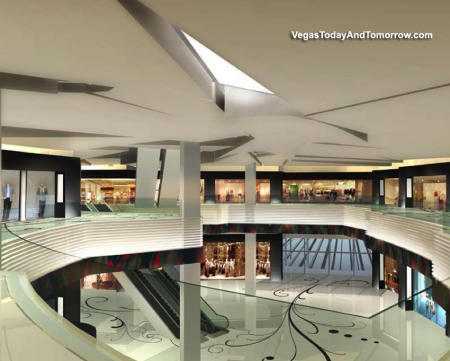 Food aside, CEO John Unwin is presupposing big spending by upper-middle class customers (time to take out another adjustable-rate mortgage, folks) but it’s far more consumer-friendly in both offerings and affect than chilly, exclusive Crystals. Incidentally, although the Cosmo spa won’t be open for a while and a few retailers aren’t ready, the resort is worlds away from the squishy-soft openings that are Vegas’ slack norm. For undisclosed reasons, we weren’t shown the buffet or the convention areas, although both were said to be finished. Nor were we vouchsafed a glimpse of the much-hyped “hidden” pizzeria, which threatens to become Vegas’ too-well-kept secret. If you’re not going to pimp it to the media, how do you expect word to get around? (Twitter, I guess.) By the bye, the Las Vegas Convention & Visitors Authority isn’t down with that whole “curious class” thing.
Food aside, CEO John Unwin is presupposing big spending by upper-middle class customers (time to take out another adjustable-rate mortgage, folks) but it’s far more consumer-friendly in both offerings and affect than chilly, exclusive Crystals. Incidentally, although the Cosmo spa won’t be open for a while and a few retailers aren’t ready, the resort is worlds away from the squishy-soft openings that are Vegas’ slack norm. For undisclosed reasons, we weren’t shown the buffet or the convention areas, although both were said to be finished. Nor were we vouchsafed a glimpse of the much-hyped “hidden” pizzeria, which threatens to become Vegas’ too-well-kept secret. If you’re not going to pimp it to the media, how do you expect word to get around? (Twitter, I guess.) By the bye, the Las Vegas Convention & Visitors Authority isn’t down with that whole “curious class” thing.
The restaurant tier centers upon a lobby with club furniture, including domino-patterned side tables. P3 Studio showcases the work of Cosmo’s artist in residence (a novel Vegas concept). STK is “a flirty, feminine take” on you know what, all curves and undulations. Estiatorio Milos is the Strip’s first Greek restaurant, to the best of my knowledge. Behind ornate metal grillework lurks the Blue Ribbon sushi bar. The voluble José Andrés was on hand to show off his Jaleo, the trademark of which will be wood-fire-cooked paella, which the chef says is the most idiomatic form of the dish, redolent of Valencia. “This is the biggest piece of engineering since the Pyramids,” Andrés declared, referring to the difficulties of drawing off the smoke from the custom-made cooker, a task complicated by competing HVAC streams sucking out smoky air from the casino and replenishing the clean oxygen. A private room at the rear of Jaleo boasts contemporary Spanish artworks.
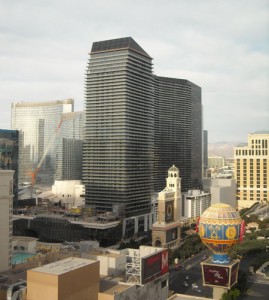 Comme ça was probably the design highlight, with its solid pewter raw bar and its Adam Tihany-crafted scheme of right angles, offset by colorful — but not gaudy — artwork. The walls are also elaborately chalked up with bon mots, a map of Paris and other atmospheric touches. The balcony looks right into the Eiffel Tower and sadly faded balloon marquee of Paris-Las Vegas, while the interior’s tile flooring promises a less-than-quiet dining experience. D.O.C.G. is an appealing-looking Italian wine bar and adjacent Scarpetta promises rustic cuisine from the land of Dante. Its long entryway is lined with dining alcoves and features bare-cement flooring. That gives way to wood in the main room, whose lazy-Susan booths overlook the Bellagio lagoon.
Comme ça was probably the design highlight, with its solid pewter raw bar and its Adam Tihany-crafted scheme of right angles, offset by colorful — but not gaudy — artwork. The walls are also elaborately chalked up with bon mots, a map of Paris and other atmospheric touches. The balcony looks right into the Eiffel Tower and sadly faded balloon marquee of Paris-Las Vegas, while the interior’s tile flooring promises a less-than-quiet dining experience. D.O.C.G. is an appealing-looking Italian wine bar and adjacent Scarpetta promises rustic cuisine from the land of Dante. Its long entryway is lined with dining alcoves and features bare-cement flooring. That gives way to wood in the main room, whose lazy-Susan booths overlook the Bellagio lagoon.
Awwwwk-ward. Digital koi fish swim across the video screens that are standard features of Cosmo elevators. These take you to the David Rockwell-designed rooms, many of which were designed as condominiums and some of which are still mired in litigation. Even the standard room boasts a pair of Samsung (yes!) HDTV sets. The furnishings are simple, almost monkish, and the layouts tend to be mailadroit, with odd sightlines. Give Cosmo props, though, for eschewing the “shat phone” by the toilet. Chuck Monster would be proud.
The largest units, on the corners, are introduced via a long, mirrored hallway that provides a Lady from Shanghai flashback. These suites have full kitchens and a wet bar. If you can afford them, it’s worth it for spectacular balcony views to the north, west and east. (I strongly suspect we weren’t shown south-facing units so’s we’d not have the amputated stump of Harmon Hotel staring us in the face.) Be careful you don’t trip over the transom, though. The bathroom is so big you and your wife could go days without seeing one another’s ablutions. However, even with such amenities as a fainting couch — something I’ve never been able to persuade my bosses to install in my office — these rooms are less impressive than comparable ones at Vdara, whose corner suites have it all over Cosmo’s, even without balconies.
Day- and nightlife. The Boulevard Pool was in the process of being made over for a Brandon Flowers concert (the sort of event which will be streamed on the nearby Cosmo marquee) but one can report that it boasts tiered daybeds and second-story cabañas. The most novel touch are little Strip-side couches for one which enable the user to overlook the boulevard below as well as the pool. A smaller pool, dubbed “The Yard,” is an Astro-turfed, shady area with tables for pool and ping pong, pinball machines and eight LCD screens.
Nightclubbers have three options. The dark, intimate and exclusive Boom Box room will be filled (shattered?) with the brain-pulverizing sounds of hip-hop. The Marquee Nightclub‘s main floor is the handiwork of the same company that brought you Tao and Lavo, and it’s by far the least interesting of the three, a drab, industrialized version of Encore’s XS. The main points of interest are a towering flyloft — from which descends a planet-sized disco ball — and the secret compartments in which ladies can store their purses.
If you seek a “Playboy After Dark” scene, there’s The Library. Its high shelves are lined with tomes (such as The Big Butt Book, I kid you not) purchased from The Strand, although one’s contemplation of the printed page is liable to be shattered by the in-house DJ. Food and “creative mixology” are on tap, while Christian Audigier-like patterns on the wallpaper proclaim that The Library is “for douchebags with class.” Outside is “dayclub” pool, lined to the south with handsome wood cabanas, with tiered, see-through mini-pools. To the south is a row of bungalows with rooftop hot tubs. (Hey, it’s Vegas. Just let Mother Nature supply the heat.) To the rear is another table game area, plus the inevitable DJ stand.
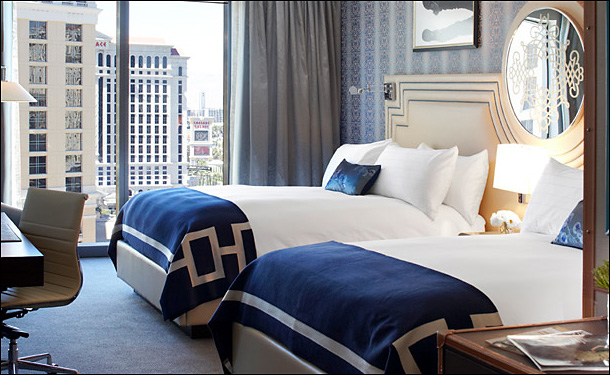
Bare-bones, Cosmo style.
In conclusion … At this point, exhaustion got the upper hand over note-taking. Heck, just reprising my Cosmopolitan experience is almost as taxing as the two-plus hours we spent traversing it, going up and down like mountain goats. The Cosmo’s got a tough row to hoe: Unless Carl Icahn decides to finish the ghastly Fontainebleau, this will probably be — in unadjusted dollars — the last $4 billion resort anybody builds on the Strip, at least until we’re firmly into the next decade. It’s been achieved with a great deal creativity and ingenuity, a feat of engineering if not always of good taste. But if you want a totally glammed-up Strip experience, Cosmo sets the bling bar very high indeed.


[…] This post was mentioned on Twitter by brock, David McKee. David McKee said: New entry; Cosmopolitan: Towers of Babel. https://www.lasvegasadvisor.com/stiffs-and-georges/?p=5350 […]
The place does sound FUN whereas the fun factor seems sort of declass at City Center, especially Crystals. I’m curious about video poker and other paytables because in Las Vegas, nothing is more fun than winning. I think Benny Binion called it “a good gamble.” City Center is a sophisticated lady but most guys will take fun over sophistication in any relationship, especially short ones. Free drinks for video poker gamblers at Cosmo bars? That sort of fun should be as mandatory as free gin in the Mayor’s office. Design wise Cosmo reminds me a bit of the old Dunes. Anyway, I cant wait to check out Cosmo in about a month and I just want to remind the team there that FUN is not a bad word or even a four-letter word.
You certainly don’t need me to tell you that was one heck of a journalistic tour you just gave us fortunate Stiffsmen! I may not make it until summer, so thank you David for giving me the two-bit tour of a lifetime. It’s about time gaudy made a Vegas comeback. I yawn through Encore and Aria. Sounds like the house-band at Cosmo should be Roxy Music. Makes me jealous of people who are able to just jump in the car and drive to Vegas like I used to do in my early twenties…
If casinos were the ladies of “Dallas,” Encore would be Sue Ellen Ewing (Linda Gray) and Cosmo would be Lucy Ewing (Charlene Tilton). As for Aria, it’d probably be Miss Ellie.
Outstanding review, I had to read it twice just to take it all in. Thank you for that great piece of work. I’ll be honest, since my hobby “obsession” with Las Vegas began, I’ve been sort of bored with all of the resort openings, and I think after reading your review I know why.
The others weren’t really for me, and the details of architecture and classy things that I have no interest in sort of bore me. While I haven’t necessarily longed for the themes of Luxor or Excalibur, I have longed for a bit of absurd on the strip again.
I have to say I’m fairly excited about seeing Cosmo. Can we essentially call this a James Bond themed resort? Perhaps inspired might be a better description.
My only hope is that they are able to land a buyer at some point that isn’t MGM, and that they are able to find their own market.
Thanks for your review of Cosmopolitan. I looked at all the pictures (156) on ratevegas.com and I was really impressed. But you bring up an excellent point when you said there were 14 different decorators on Cosmopolitan and when everything is thrown together like that it resembles a “blitzkrieg upon your eyeballs.”
[…] and design/decoration aimed squarely at females (local Las Vegas writer and blogger David McKee stated “In sensibility, it’s the gayest thing to hit the Strip since Liberace”, and you […]
Courtesy of an LVA comp a couple of years ago I was able to stay 2 nites in a strip view 1 bedroom suite with kitchen and balcony(total cost the resort fee $62) Those rooms were designed to be time share and included a lot of unusual room “decorations”, books and toys. Too expensive to drink and eat at for me but fun place to people watch.